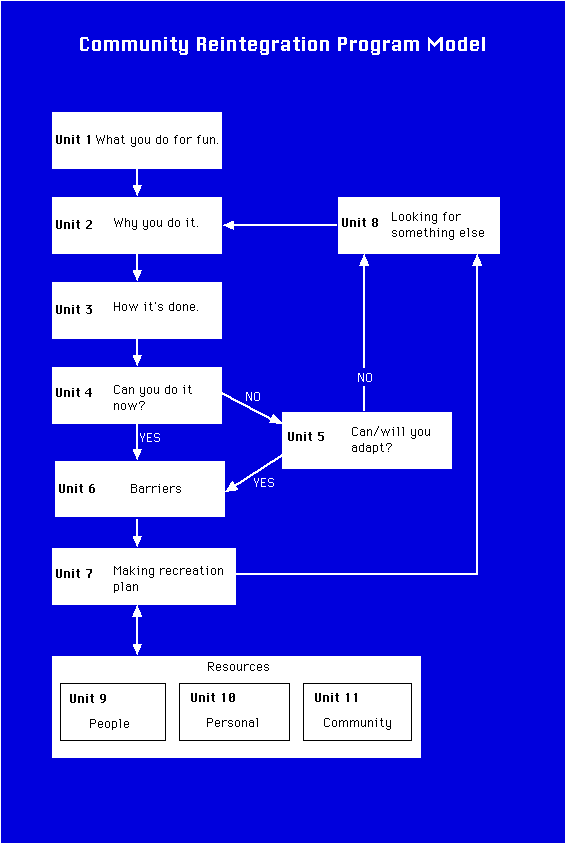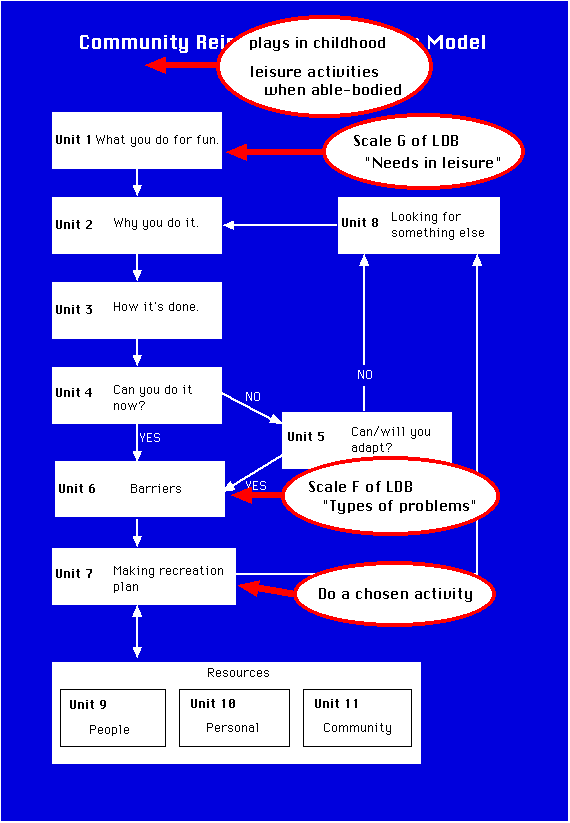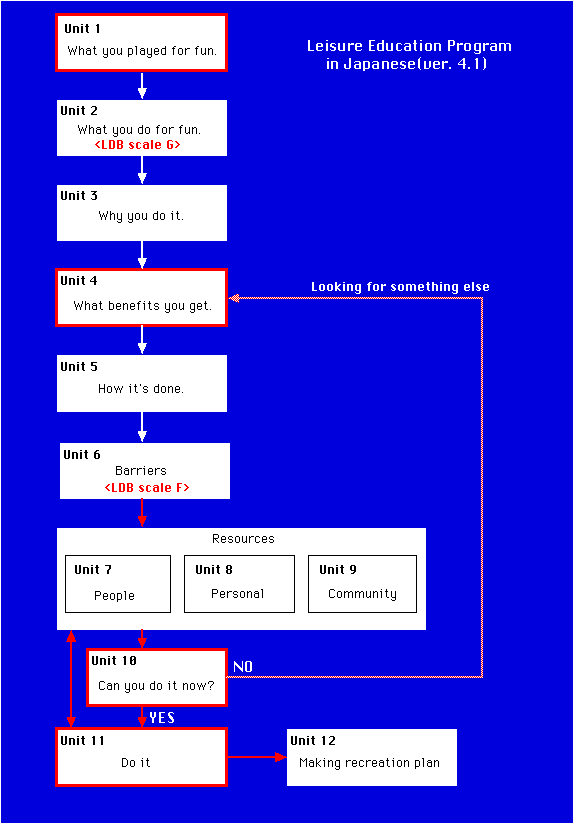|
an inTeRlink feature
article
An Application
and Effects of the Leisure Education Program in Japanese (LEP-J) on Independence
in Leisure Among the Clients in the Independent Living Training Center.
Hiroaki Chino (Mukogawa Women's University,
Department of Human Sciences)
From September 2000 presentation at annual
ATRA conference in Cincinnati.
1. The Independent Living Training Center
The Independent Living Training Center is a part of Hyogo Rehabilitation
Center. The Center is located in western Kobe, about 400 miles southwest
of Tokyo, Japan.
The objective of the Center is to provide
a variety of psycho-social training programs for enhancing independent
living skills of the physically disabled. These programs are in operation
and include:
(1)Training in ADL, driving , and sports;
(2)Vocational education including pre-vocational programs and education
programs;
(3)Recreation programs.
There are two types of recreation programs
provided in the Center as follows:
(a)Prescriptive group activity programs such as playing group games,
singing, and dancing
(b)Club activities such as wheelchair basketball, flower arrangement,
tea ceremony, archery, tennis, and so on.
Although various training programs are provided in the Center to achieve
independent living skills for each client, no individual program has
been offered in relation to leisure and recreation. Moreover, case workers
have been striving to develop a program which facilitates the transition
of lifestyle in the Center into a community setting. In a sense, LEP-J
appears to be appropriate to meet this need.
2. The Leisure Education Program in Japanese
(LEP-J)
(1)Community Reintegration Program: Origin of LEP-J
Drs. Bullock and Howe developed the Leisure Education Program(LEP) entitled
as the Community Reintegration Program in 1989. The Leisure Education
Program in Japanese(LEP-J) is developed based on their program.
The goal of LEP-J is the same as the Program
by Drs. Bullock and Howe that is to to facilitate freely chosen leisure
involvement as a way to restore/enhance optimal functioning upon return
to the community.
The final behavioral objective is that a client will demonstrate an
ability to carry out a leisure activity independently selected by herself/himself.
LEP-J has been utilized as a part of phycho-social
rehabilitation services in the Independent Living Training Center since
1997.
(2)Differences in two programs
Although both LEP and LEP-J consist of 12 units, there are some differences
in contents. LEP-J has been added the followings:
(a) to remember plays in childhood and/or leisure activities before
having a disability;
(b) to understand own needs in leisure(Scale G of Leisure Diagnostic
Battery);
(c) to understand types of problems to achieve(Scale F of LDB);
(d) to experience a chosen activity.
3. Assessment
(1) Intrinsic Leisure Motivation in Japanese (ILM-J) for leisure activeness
ILM-J was developed based on the Intrinsic Leisure Motivation Scale
(ILM) by Drs. Weissinger and Bandalos(JLR, 27, 379-400). Unlike ILM,
ILM-J can only be used for activeness , studied by Nomura, et al (1997).
(2) Leisure Boredom Scale in Japanese (LBS-J)
for leisure boredom
LBS-J was developed based on the Leisure Boredom Scale (LBS) by Drs.
Iso-Ahola and Weissinger(JLR, 22, 1-17). LBS-J has high validity, just
like LBS.
(3) Interview to the client
i.e., home town, cause of disability, goals at the Center, medication,
etc.
(4) Case conference for each client with
the instructors.
i.e., family, income, other private information.
4. Planning
(1)To make an Individual Program Plan for each client based on assessment
5. Implementation
(1) a 60-minute session held on every Monday at 3 pm.
There is no obligation to attend LEP-J.
Duration of LEP-J varys from 3 months to 16 months.
(2)Staff utilizes facilitation techniques
to each client.
(3)client will experience an activity chosen
by himself / herself.
(4)Each client is encouraged to report
the instructor what he is doing in LEP-J.
(5)Staff members are:
(a) 1 researcher
(b)1 instructor
(c) 5 trained volunteers(students and others)
6. Evaluation
(1)ILM-J for leisure activeness
(a)positive discrepancy(Post-test to Pre-test) will show gain in activeness
(b)negative discrepancy will show loss in activeness
(2)LBS-J for leisure boredom
(a)positive discrepancy will show gain in boredom
(b)negative discrepancy will show loss in boredom
(3)Changes of answers in #6, #10 of LBS-J
(a)#6 In my leisure time, I usually don't like what I'm doing, but I
don't know what else to do.
(b)#10 In my leisure time, I want to do something, but I don't know
what I want to do.
<scales are: 1:Strongly Disagree 3:Neutral 5:Strongly Agree>
(4)Comments, impression, and suggestions reported by the client
(a)To acquire an ability to plan total lifestyle in the community.
(b)To become active in leisure as well as in a daily life.
(c)To understand myself.
(d)To acquire leisure skills.
(5)Any changes in behavior and/or attitude
reported by the instructor
For example,
(a)Positive changes toward ADL-training observed
(b)Becoming active in daily life
(c)Acceptance of the disability as a result of LEP-J
(d)Becoming confident to live independently in the community
(6)A summary report of effectiveness of
LEP-J on the client submitted by the researcher
It includes client's name, a selected leisure activity, changes in scores
of ILM-J & LBS-J, any changes in behaviors and/or attitude, and
summary of the case.
7. How the client is involved in LEP-J?
(1) Dissemination of LEP-J
(a) LEP-J is introduced by the instructor to the clients who may have
some possibility to change in functions through LEP-J.
(b) The clients, who have finished LEP-J, may introduce it to other
clients.
(2)Guidance to the client
(a) Introducing LEP-J
Such as purpose, relationship between the clients and LEP-J staff, degree
of freedom and own responsibility, and so on.
(b) Being able to drop out anytime.
(c) Try to think about things that make you feel good and happy.
(3)Client's decision
(a) Yes ¨ start to participate in LEP-J
(b) No ¨ tell the instructor



All rights reserved.
|